Angela Ackerman's Blog: Writers Helping Writers, page 135
June 12, 2016
The Setting Thesaurus Is Here: Writers, Get Ready To Rock The Vault
At long last, The Setting Thesaurus is here. Split into two volumes, Urban and Rural, these books are the result of several years’ worth of traveling, documenting, and researching.
What is a Setting Thesaurus, you ask?
Well, imagine having access to the sights, smells, tastes, textures, and sounds your character may experience in 225 different contemporary settings. And that’s just to start.
Not only can you use this sensory detail to create a rich world that will draw readers in, these books can also show you how to choose the right location for each scene so that the setting creates conflict, steers the plot, evokes mood and emotion, provides challenges, and opens a window into the deepest parts of your character, revealing who they are, what they believe, and what motivates their every action.
 But enough about that. After all, The Urban and Rural Setting books are just two of the amazing Thesauruses out there, and this week, we want to celebrate them all.
But enough about that. After all, The Urban and Rural Setting books are just two of the amazing Thesauruses out there, and this week, we want to celebrate them all.
I’m sure, like us, you have your favorites.
Roget’s, The Thinker’s Thesaurus, The Emotion Thesaurus, The Dialogue Thesaurus…they help us grow as writers, strengthening our vocabulary and knowledge of writing craft. And whichever thesaurus you cherish most, we want to hear all about it.
Here’s a little nerdy secret about Becca and I: we have a Thesaurus Club. I don’t want to brag, but it’s pretty swell, complete with a secret entrance, underground library and prize vault.
Whoa, what?
Yes, a prize vault. And it’s packed with stuff, goodies we’d really like to pass on to you.
 So, we’re providing a challenge to fellow thesaurus enthusiasts:
So, we’re providing a challenge to fellow thesaurus enthusiasts:Post a picture of your favorite thesaurus on twitter, facebook or instagram and add the hashtag #myfavoritethesaurus
The more pictures and hashtags we see, the more prizes will be “unlocked” from the vault!
If 500 original pictures using the #myfavoritethesaurus hashtag are shared, we’ll bust open the vault. ALL prizes will be unlocked and drawn at the end of the week. If we don’t reach 500, whichever prizes are unlocked at the end of the event will be in the draw.
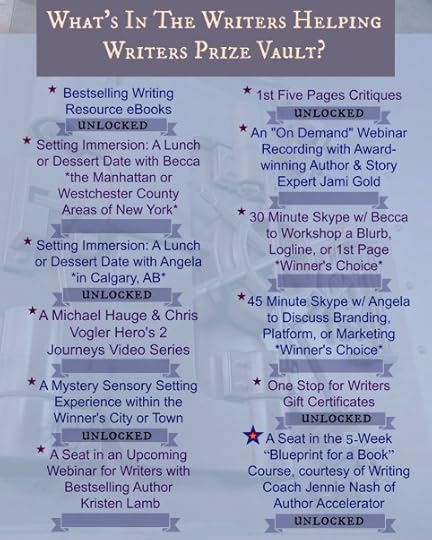 (I don’t want anyone to freak out, but there’s around $800 worth of writerly goodness going on here. That, my friends, is a lot of awesome.)
(I don’t want anyone to freak out, but there’s around $800 worth of writerly goodness going on here. That, my friends, is a lot of awesome.)
The question is, are you up to the task? Can you unlock all these amazing prizes?

Check out #myfavoritethesaurus! Do you have a favorite one too? http://writershelpingwriters.net/
It’s easy! Grab a copy of your favorite thesaurus, print or digital. Snap a picture, like this one, and share it.
Throughout the week, Becca and I will be counting pictures using the #myfavoritethesaurus hashtag.
The more original pictures that are shared, the more prizes we will unlock. It’s that simple!
And as you can see, there are already some terrific prizes unlocked and ready to be won. As we count up to 500, we will unlock prizes along the way, and update the prize page.
How To Unlock Prizes In Our Vault
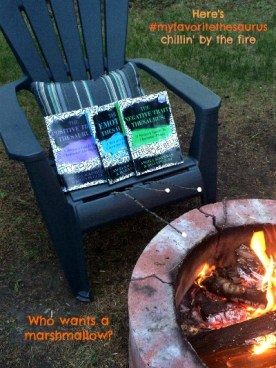
A trio of #myfavoritethesaurus! Come join the fun, and Rock The Vault! http://writershelpingwriters.net/
1) Take a picture of your favorite thesaurus book using your smartphone–digital or print. If you like, have fun with it by showing the book in a “setting” of your choosing!
2) Include the #myfavoritethesaurus hashtag when you share it
3) Tag Becca or I
…on twitter: @beccapuglisi & @angelaackerman
…or, on facebook: Becca Puglisi & Angela Ackerman
…or, on instagram: writers_helping_writers_angela
Questions you might have:
Can I upload more than one picture?
–Yes! But each picture needs to be a different thesaurus. You DO have more than one favorite, right? 
Do retweets and shares count?
–No, sorry. We’re going to be counting original photos. BUT, if we see lots and lots of tweets and retweets, we may add EVEN MORE prizes… *hinty-hint*
What is a “Mystery Sensory Setting Experience?” It sounds pretty awesome.
Oh, it is. Visit the detailed prize listing page HERE to find out all about it & our other AMAZING prizes.
 Ready to Rock the Vault? See you on Facebook, Twitter & Instagram! #myfavoritethesaurus
Ready to Rock the Vault? See you on Facebook, Twitter & Instagram! #myfavoritethesaurusTo enter to WIN some of these amazing prizes, just visit this page and fill out our form.
(And tell your friends…let’s see the writing community work together to UNLOCK all of these prizes.)
 It is always hard to kick start an event after a tragedy like what occurred in Orlando yesterday. Our hearts are with the victims and their families, and no disrespect is intended by proceeding with this book launch.
It is always hard to kick start an event after a tragedy like what occurred in Orlando yesterday. Our hearts are with the victims and their families, and no disrespect is intended by proceeding with this book launch.
Love to all.
Save
Save
Save
Save
Save
Save
Save
Save
Save
Save
Save
Save
Save
Save
Save
Save
Save
Save
Save
The post The Setting Thesaurus Is Here: Writers, Get Ready To Rock The Vault appeared first on WRITERS HELPING WRITERS™.
June 7, 2016
Something Big Is Coming…
Today’s a special one for Becca and me. In less than a week, we will be expanding our thesaurus family by adding The Rural Setting Thesaurus: A Writer’s Guide to Natural and Personal Places and The Urban Setting Thesaurus: A Writer’s Guide to City Spaces.
We are very excited about these books, and hope they’ll change how you think about setting and description. Sensory detail, a large part of each book, is an especially powerful way to draw readers into our story’s world, so we really need to get it right.
Are you up for a short trip, dear blog reader? I’d like to show you exactly what I mean.
 There’s a place Becca and I go, somewhere special. And, well, we have something there that I think you’ll want to know more about.
There’s a place Becca and I go, somewhere special. And, well, we have something there that I think you’ll want to know more about.
You’re in? Great! Let’s head out now. The air is cooler with the sun tucking itself in for the night, and as shadows grow longer, there’s less chance we’ll be seen.
 See that door at the edge of the old Abbey’s courtyard? That’s out ticket past the city walls unseen. Each year, the ivy strangles it a bit more, and few even know it’s here. As far as I know, Becca and I have the only keys. Heavy buggers too, these knobby pieces of iron. Always dragging at our pockets.
See that door at the edge of the old Abbey’s courtyard? That’s out ticket past the city walls unseen. Each year, the ivy strangles it a bit more, and few even know it’s here. As far as I know, Becca and I have the only keys. Heavy buggers too, these knobby pieces of iron. Always dragging at our pockets.
Damn, stuck. Help me give it a shove? Just watch the ivy. It’s slick with dew and if a piece happens to slither up against your neck, you’re apt to scream. And, well, clearly a hidden exit is only useful if it stays a secret.
Ah, that’s better. Out here, there’s lots of tree cover, and dusk is closing in. We should be safe from prying eyes.
I love the woods, don’t you? Each breath is fresh and sharp with the tang of pine. Odd though, how the mist is rolling in so quickly. I can almost feel it, like a wet glove sliding across my skin.
And not to start something, but does it seem..a bit too quiet? Even our shoes are barely scuffing the trail. I don’t know, maybe the fog swallows the sound or something. You’re not from around here and so probably don’t know, but a few years back, a couple came this way on a hike and simply…disappeared. All their gear–backpacks, climbing poles, water bottles–sitting in a pile on the trail. But them? Nothing. No trace.
I know, such a morbid thing to bring up. Still, let’s pick up the pace a bit?
Ahead, that tunnel at the end of those tracks? We’re headed in there.
Oh, the look on your face. Priceless. I wish you could see it!
Don’t worry, it’s barely a scrap of dark. No boogeymen, I promise. Besides, I brought my headlamp, see? Trust me, Becca and I have come this way dozens of times. It’s safe. One hundred percent. Would I lie to you?
So let’s go.
 Okay, so I maybe I forgot to mention this part about a ladder. And, you know, going underground. But here’s the thing…if I’d told you about this shaft, you might have never agreed to come in the first place!
Okay, so I maybe I forgot to mention this part about a ladder. And, you know, going underground. But here’s the thing…if I’d told you about this shaft, you might have never agreed to come in the first place!
And really, you’ve come this far. What’s a tiny bit further? What’s waiting is worth it.
I’ll go first, so you can follow the light down. Hold onto the bars tightly because rust is settling in. If some of the metal flakes away and your hand slips…well, best we don’t think about that.
Ta-da, solid ground. Feels good, doesn’t it? You were a champ, truly. Nicely done.
And guess what? If you open your eyes, you’ll see we’re here.
 This is it: the writing cave. Our very own Thesaurus Club. Pretty amazing, right? Lights. Electricity. High speed wi-fi. Becca and I pulled some strings to make this happen, let me tell you.
This is it: the writing cave. Our very own Thesaurus Club. Pretty amazing, right? Lights. Electricity. High speed wi-fi. Becca and I pulled some strings to make this happen, let me tell you.
No one bothers us here–it’s terrific! We can really dig in get some serious writing done. When that fireplace is crackling and wood smoke is in the air, well, you’d love it. Home away from home.
Ah, you spotted our vault. Sharp eye, my friend, sharp eye. Manufactured steel, twelve inches thick, twenty bolts, and completely fire, flood, and apocalypse proof. It’s quite the door, no two ways about it.
 Bet you’re wondering what’s in there, am I right?
Bet you’re wondering what’s in there, am I right?
Sure, I would be too, if I were in your shoes. I mean, that’s some serious hardware for a writing cave.
And…I would like to tell you. I would. But Becca, well, she’s a bit intense about this stuff. And what is behind this door is something we’re going to talk about on June 13, the official release date for our Setting Thesaurus books.
But I wanted you to see it today. I wanted you to know how to get here. So you can come back, on your own, in just a few days.
…Because you are going to want to come back.
…You are going to want to know what’s behind this door.
Mark your calendar. Set a reminder on your phone. Write the date in permanent ink on your palm.
And take this key, the one for the abbey door. Tuck it away. Don’t lose it, whatever you do.
Remember, what happens in the Thesaurus Club stays in the Thesaurus Club.
The next meeting is June 13th, and you’re invited. Don’t be late. You won’t want to miss it, not for the world.
The Setting Books are almost here, but in the meantime, try out a sample. Becca’s sharing wisdom on How Writers Can Bring Setting to Life through Personification at Live Write Thrive. And her recent podcast on Writing Captivating Novels Using the Emotion and Setting Thesaurus is like a mini master class.
See you on the 13th!

Image 1: Unspash @ Pixabay
Image 2: Unsplash @ Pixabay
Image 3: Unsplash @ Pixabay
Image 4: Silberfuchs @ Pixabay
Image 5: Hans @ Pixabay
Image 6: tpsDave @ Pixabay
Image 7: DasWotgewand @ Pixabay
Image 8: skeeze @ pixabay
The post Something Big Is Coming… appeared first on WRITERS HELPING WRITERS™.
June 4, 2016
Emotional Wounds Entry: Being Stalked
When you’re writing a character, it’s important to know why she is the way she is. Knowing her backstory is important to achieving this end, and one of the most impactful pieces of a character’s backstory is her emotional wound. This negative experience from the past is so intense that a character will go to great lengths to avoid experiencing that kind of pain and negative emotion again. As a result, certain behaviors, beliefs, and character traits will emerge.
Characters, like real people, are unique, and will respond to wounding events differently. The vast array of possible emotional wounds combined with each character’s personality gives you many options in terms of how your character will turn out. With the right amount of exploration, you should be able to come up with a character whose past appropriately affects her present, resulting in a realistic character that will ring true with readers. Understanding what wounds a protagonist bears will also help you plot out her arc, creating a compelling journey of change that will satisfy readers.
NOTE: We realize that sometimes a wound we profile may have personal meaning, stirring up the past for some of our readers. It is not our intent to create emotional turmoil. Please know that we research each wounding topic carefully to treat it with the utmost respect.

Patrik Nygren @ Creative Commons
Examples: Being undesirably and relentlessly pursued by someone. Stalkers are typically obsessed with their subjects, either out of a romantic interest or from the perception that the subjects have rejected or slighted them in some way:
a fan whose mail was unanswered
an ex
a student whose scholarship application was denied
an artist whose work failed to win a contest or received a poor review
someone with romantic interests whose advances were rejected
an employee overlooked for a promotion
a parent whose child was disrespected or rejected
an athlete/artist/performer who has been replaced by a more talented competitor
Basic Needs Often Compromised By This Wound: physiological needs, safety and security, long and belonging, self-actualization
False Beliefs That May Be Embraced As a Result of This Wound:
I have encouraged this person in some way.
If I hadn’t done X, then this wouldn’t be happening to me.
I’m a target—someone others identify as weak.
My judgment is flawed; I should have seen this person as a threat from the beginning.
I’ll never be free of this person.
I’ll never be safe again.
I’ve brought danger to my friends and family.
The authorities are powerless to help me.
If this person could do this to me, anyone could. I can’t trust anyone.
Positive Attributes That May Result: alert, appreciative, cautious, disciplined, discreet, empathetic, focused, independent, nurturing, observant, private, proactive, protective, resourceful, sensible
Negative Traits That May Result: addictive, confrontational, controlling, defensive, hostile, humorless, impatient, indecisive, inflexible, inhibited, insecure, irrational, needy, nervous, nosy, obsessive, paranoid, resentful, self-destructive, subservient, suspicious, temperamental, timid, uncommunicative, uncooperative, violent, volatile, worrywart
Resulting Fears:
Fear for one’s life
Fear that the stalker will hurt one’s loved ones
Fear that one’s judgment/intuition can’t be trusted
Fear of new people
Fear of going to new places or going places alone
Fear that the stalking will never end
Fear of not being believed
Possible Habits That May Emerge:
Insomnia and fatigue
Loss of appetite
Weight gain from eating to comfort oneself
Isolating oneself; avoiding unnecessary social interactions
Avoiding social media
Clinging to those one knows is safe
Relying on trusted loved ones to make decisions due to doubting one’s discernment and judgment
Becoming overprotective of one’s loved ones and pets
Becoming overly suspicious and paranoid
Mental disorders (panic attacks, agoraphobia, depression)
PTSD symptoms (nightmares, flashbacks, startling easily, irritability)
Difficulty focusing on everyday tasks
Making changes to throw off a stalker (moving, changing jobs, changing one’s name, altering one’s appearance)
Becoming very concerned with personal safety (adding a security system, taking a self-defense class, getting a dog, etc.)
Self-medicating
Thinking about or attempting suicide
Hypertension, gastrointestinal issues, sexual dysfunction, and other physical symptoms associated with excessive stress
Performing poorly at work or school
Giving up hobbies and activities that take one out of the home
Difficulty trusting others
TIP: If you need help understanding the impact of these factors, please read our introductory post on the Emotional Wound Thesaurus. For our current list of Emotional Wound Entries, go here.
For other Descriptive Thesaurus Collections, go here.
Also, there are eight days left in our Goodreads giveaways of The Urban Setting Thesaurus and The Rural Setting Thesaurus. Wanna score a print copy? Enter to win!
The post Emotional Wounds Entry: Being Stalked appeared first on WRITERS HELPING WRITERS™.
May 31, 2016
Level Up Your Setting By Thinking Outside The Box
With the Urban and Rural Setting Thesaurus books releasing in just two weeks (June 13th), pretty much all I can think about is the setting, ergo today’s topic. You guys have no idea how much Becca and I are loving all the tweets, emails, comments and posts from all of you about these upcoming books–thanks so much for your enthusiasm and support! And, because we know waiting is hard, we’ve created a Goodreads giveaway for each volume of The Setting Thesaurus, so stop in and enter if you like.
Okay, moving on… 
With writers, there seems to be two camps: those who love writing setting description, and those…who…don’t. There isn’t always a lot of middle ground.
Becca is definitely in the former group. She’s freakishly good at world building. Each setting she writes feels like a living, breathing place, yet distilled to have clarity and purpose, so only the most important bits are shown without disrupting the pace or action.
For many, when it comes to describing the setting, the words don’t immediately flow. Some of us (cough-me-cough) tend to write on the leaner side of things, especially early on, and it is only in later drafts we put more “meat” on the setting “bone.”
Here’s the good news: regardless of whether you embrace setting description or not, one way to level up your writing is to think hard about each location you choose. The “where” of each scene is an important factor, and worth the extra time to plan. Here’s two big reasons why:
It Achieves Story and Character Depth
The right setting can greatly enhance our story, providing tests and challenges for our hero to overcome (the Black Gate in The Lord Of The Rings, or the Cornucopia in The Hunger Games), fortify the character, reminding them of their greatest assets (Hermione and the Hogwarts library come to mind) or allow the ghosts of the past to resurface and shape a character’s vulnerability (the sewers in Stephen King’s It.)
 The location can even reinforce a character’s deepest longing (the Notre Dame stadium in Rudy), and act as a tangible reminder of a missing Human Need (The Incredibles’ Bob Parr, an unfulfilled insurance claims adjustor in his cramped office, who needs to be something more, something greater.)
The location can even reinforce a character’s deepest longing (the Notre Dame stadium in Rudy), and act as a tangible reminder of a missing Human Need (The Incredibles’ Bob Parr, an unfulfilled insurance claims adjustor in his cramped office, who needs to be something more, something greater.)
Takeaway tip: When choosing a setting for the scene’s events, look at what is going to happen, and make a list of setting choices that can reveal something deeper about the characters involved. The setting should act as a symbol for one or more of the elements above, bringing forth deeper meaning and making characters and their desires matter more to readers.
It Offers Readers a New Experience
 One of the big promises we make to readers is that we will take them on a journey that is somehow new and fresh. One way to achieve this is through setting choice. After all, do we really want to show them the same location they’ve read about a million times before? And while genre might influence the range of settings that one might expect to see, this shouldn’t hold a writer’s creativity hostage.
One of the big promises we make to readers is that we will take them on a journey that is somehow new and fresh. One way to achieve this is through setting choice. After all, do we really want to show them the same location they’ve read about a million times before? And while genre might influence the range of settings that one might expect to see, this shouldn’t hold a writer’s creativity hostage.
Take the typical party scene, a common sight in many contemporary Young Adult novels. This event doesn’t always have to be at the beach or in someone’s house while the parents are away. Why not have your teenagers sneak into a shutdown construction site or an empty warehouse that’s up for sale, instead? Add some beer, a few spray cans, and the unexpected appearance of a security guard with a stun gun, and you’ve got a unique setting primed for a storm of conflict, plus you’re offering readers something new to experience.
Takeaway Tip: If you start with the scene’s action, make a list of all the obvious places this exchange or event could take place. Then, branch out, thinking about locations that logically fit with your characters’ general location, but offer fresher setting options.
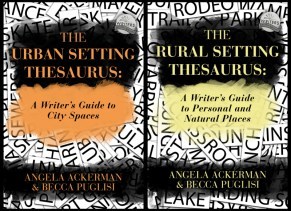 Make Something Familiar New
Make Something Familiar NewNow if you do find yourself using a familiar setting out of necessity, don’t worry. Just strive to make it unique through different factors. The time of day or night, the quality of light, the season, the weather, and the POV character’s emotional filter will all help you transform the location into something tailor made.
Plus, you can turn your setting into an obstacle course to differentiate it further, because setting is also a vehicle for conflict.
 Bonus Tip!
Bonus Tip! Not only do our two new Setting Thesaurus books have the sights, smells, tastes, sounds and textures of 225 locations to kick-start your imagination, you can find a list of both volumes’ settings at One Stop For Writers to mine for ideas, even if you are not a subscriber of the site.
Simply register (always free) and click on The Setting Thesaurus in the menu. If you are a subscriber, you can access all the entries in full, as the setting thesaurus books have already been uploaded to the One Stop site.
Do you think “outside the box” when it comes to setting? What are some of the more unusual locations you’ve chosen?
Image 1: Antranias@ Pixabay
Image 2: Unsplash @ Pixabay
The post Level Up Your Setting By Thinking Outside The Box appeared first on WRITERS HELPING WRITERS™.
May 28, 2016
Deepen The Protagonist to Readers By Challenging His or Her Moral Beliefs
When we sit down to brainstorm a character, we think about possible qualities, flaws, quirks, habits, likes and dislikes that they might have. Then to dig deeper, we assemble their backstory, plotting out who influenced them, what experiences shaped them (both good and bad) and which emotional wounds pulse beneath the surface. All of these things help us gain a clearer sense of who our characters are, what motivates them, and ultimately, how they will behave in the story.
 But how often do we think about our protagonist’s morality? It’s easy to just make the assumption that he or she is “good” and leave it at that.
But how often do we think about our protagonist’s morality? It’s easy to just make the assumption that he or she is “good” and leave it at that.
And, for the most part, the protagonist is good–that’s why he or she is the star of the show. The protagonist’s moral code dictates which positive traits are the most prominent (attributes like loyalty, kindness, tolerance, being honorable or honest, to name a few) and how these will in turn influence every action and decision.
In real life, most people want to believe they know right from wrong, and that when push comes to shove, they’ll make the correct (moral) choice. People are generally good, and unless you’re a sociopath, no one wants to go through life hurting people. Sometimes it can’t be avoided, but most try to add, not take away, from their interactions and relationships.
To feel fully fleshed, our characters should mimic real life, meaning they too have strong beliefs, and like us, think their moral code is unshakable. But while it might seem it, morality is not black and white. It exists in the mists of grey.
 In the movie Prisoners, Hugh Jackman’s plays Keller, a law-abiding, respectful man and loving father. But when his daughter is abducted and police are ineffective at questioning the person he believes to be responsible, he is forced into a moral struggle.
In the movie Prisoners, Hugh Jackman’s plays Keller, a law-abiding, respectful man and loving father. But when his daughter is abducted and police are ineffective at questioning the person he believes to be responsible, he is forced into a moral struggle.
Keller needs answers, but to obtain them, he must be willing to do things he never believed himself capable of. Finally, to gain his daughter’s freedom, he kidnaps the suspect and tortures him repeatedly.
In each session, Keller battles with his own humanity, but his belief that this man knows where his daughter is outweighs his disgust for what he must do. It is not only Keller’s actions that makes the movie compelling, it is the constant moral war within the grey that glues us to the screen.
Extreme circumstances can cause morals to shift. What would it take for your “moral” protagonist to make an immoral choice?
Is your character deeply honest? What might push her to lie about something important?
Is your character honorable? What would force him to act dishonorably?
Is your character kind? How could life break her so that she does something maliciously hurtful?
When your protagonist is forced to enter a grey area that causes them to question what is right and wrong…this is where compelling conflict blooms!
YOUR TURN: Have you built in situations that force the hero to evaluate his morality? If not, what can you do within the scope of your story to push him into the grey where he must wrestle with his beliefs? What event might send him to the edge of himself, of who he is, and possibly force him to step across the line dividing right and wrong?
Tools to help you understand your character better:
The Reverse Backstory Tool: Hit all the highlights on your hero’s backstory reel, including his Emotional Wound & The Lie He Believes About Himself
The Character Target Tool: Set the path of your hero’s positive traits, spiraling out from Moral based attributes
The Character Pyramid Tool: Plot your character’s flaws that stem from a Wounding Event &visualize how these flaws present as behaviors & thoughts
(& even more tools HERE)
Originally posted at IWSG
Image #1 Brenkee @ Pixabay
The post Deepen The Protagonist to Readers By Challenging His or Her Moral Beliefs appeared first on WRITERS HELPING WRITERS™.
May 23, 2016
Five Ways to Help Your Favorite Authors
So, as you may have heard, Angela and I are in the process of publishing the next books in our thesaurus series: we’re so excited that The Urban Setting Thesaurus and The Rural Setting Thesaurus will be available for purchase June 13th!
Though we’ve been through this process twice already, it’s been almost 3 years since our last books were released, and it’s surprising how much has changed in that time. In some ways, we’ve had to start from scratch and re-educate ourselves about how the whole thing works. As we’ve looked into giveaways, marketing opportunities at Amazon, how to enhance author bios and profiles at various distributors, etc., we’ve discovered so many ways to maximize our marketing efforts. But we’ve also learned about some new things that we, as readers, can do to support our favorite authors. And because we’re all about helping authors, we wanted to share those with you.
1. Follow your favorite authors on Amazon. The majority of authors have an author page at Amazon containing a bio, information about their books, author-posted videos and blog posts, and more. All of that is readily viewable by clicking on the author’s name under the listing for one of his or her books.
But if you also follow that person on Amazon, you’ll receive an email notification when he or she releases a new book.
This is great for you, so you can stay up to date on new books that you’ll want to know about, but it’s also helpful for the author because it’s a way for them to get the word out about about their newest publications.
2. Follow your favorite authors at Goodreads. Following an author at Goodreads reaps the same benefits as following one at Amazon: you’re able to access personal information about that author, read posts imported from the author’s blog, see all the books written by the author, and be informed of new releases when they’re published. To follow an author, type his or her name in the Search bar, click on the name anywhere it appears in the results, then click the yellow Follow button under his or her picture.
If you want to receive notifications about new releases by your favorite authors, you just need to turn that option on. To do that, follow these steps:
Hover over your profile image on the top right of the screen.
Click Account Settings.
On the right-hand side of the page, click the little Edit My User Profile link.
Click on Emails.
Scroll down to the Newsletters and Other Mail section. Tick the box that says Email me when an author I follow releases a new book.
3. Add upcoming releases to your Goodreads To Read list. This one is potentially awesome because many authors choose to host a giveaway of their new books leading up to their publications. So let’s say Stephen King is releasing a new book. If you’ve followed him, when he adds his new release to Goodreads, you’ll receive a notification. You will, of course, rush to add his book to your To Read list. Then, let’s say the King decides to host a giveaway of that book. If you have the correct notification turned on, you’ll receive a message about that giveaway. This is a great opportunity for both readers and authors; readers will get a chance to win a free copy of one of their favorite author’s new books while giving that author an opportunity to tell fans about new releases.
To turn on that notification, just follow the directions in the second bullet point above. But in step 5, go to the Comments and Action Notifications section and turn on the option to receive notifications when someone Lists a Giveaway with a book I added as To-Read.
4. Ask for favorite books to be stocked at your library. Love affairs are born between readers and books at the local library. This is where I first encountered Robin McKinley, Shannon Hale, Garth Nix, and Anne McCaffrey, and I went on to buy most of their books. Visibility is difficult for today’s authors—especially for new authors, and libraries tend to stock books that are popular or highly marketed. So if you have a favorite author, get online and see if your local library carries a copy. If it doesn’t, swing by the reference desk the next time you’re there and ask the media specialist if they can order a copy.
5. Write Reviews. This one has been said so many times, but as a reader, I know how easy it is to forget to review a good book, so I think it bears repeating. With so many books on the market today, it’s hard for people to know which ones are worth buying. More and more, readers are turning to reviews to help them narrow the field. So when you write a heartfelt review at Amazon, Goodreads, your blog, or anywhere people are likely to see it, you lend credibility to that book and encourage people to take a chance on it. In a market where visibility is hard to come by, this is incredibly helpful for authors.
One thing that Angela and I love about the writing community is its eagerness to band together and support others. I hope these ideas help you help writers. If you have other ideas for how to support a favorite author, please add them in the comments section.
Also, I’m speaking at Elizabeth Spann Craig’s incredible blog today about using the setting to add conflict to your scene. Stop by and say hello!
Also, also, we’re currently testing out the Amazon Giveaway feature, ’cause we’re daredevils that way. Just click the links to enter to win one of 3 kindle copies of The Negative Trait Thesaurus and The Positive Trait Thesaurus.
The post Five Ways to Help Your Favorite Authors appeared first on WRITERS HELPING WRITERS™.
May 21, 2016
Emotional Wound Thesaurus Entry: Failing at School
When you’re writing a character, it’s important to know why she is the way she is. Knowing her backstory is important to achieving this end, and one of the most impactful pieces of a character’s backstory is her emotional wound. This negative experience from the past is so intense that a character will go to great lengths to avoid experiencing that kind of pain and negative emotion again. As a result, certain behaviors, beliefs, and character traits will emerge.
Characters, like real people, are unique, and will respond to wounding events differently. The vast array of possible emotional wounds combined with each character’s personality gives you many options in terms of how your character will turn out. With the right amount of exploration, you should be able to come up with a character whose past appropriately affects her present, resulting in a realistic character that will ring true with readers. Understanding what wounds a protagonist bears will also help you plot out her arc, creating a compelling journey of change that will satisfy readers.
NOTE: We realize that sometimes a wound we profile may have personal meaning, stirring up the past for some of our readers. It is not our intent to create emotional turmoil. Please know that we research each wounding topic carefully to treat it with the utmost respect.
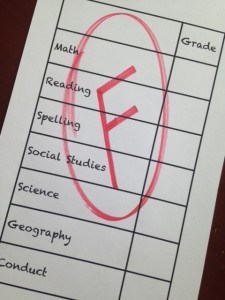 Examples: Struggling throughout one’s school career due to
Examples: Struggling throughout one’s school career due to
a learning disorder (dyslexia, dysgraphia, processing disorders, etc.)
a behavioral or mental disorder (anxiety, ADHD, panic attacks, depression, bipolar)
medical problems that caused one to miss a lot of school
taking medication that interferes with one’s ability to focus or learn
having a low IQ
getting no support at home
external pressures that make school a low priority (working multiple jobs to provide for one’s family, suffering from malnutrition, being homeless, etc.)
Basic Needs Often Compromised By This Wound: love and belonging, esteem and recognition, self-actualization
False Beliefs That May Be Embraced As a Result of This Wound:
I’m stupid.
I can’t learn.
I’m going to fail no matter how hard I try.
I’m no good at school/math/reading/etc.
There’s something wrong with me.
I’m worthless.
My parents won’t love me if I don’t do well in school.
Positive Attributes That May Result: charming, creative, disciplined, industrious, patient, persistent, private, proactive, resourceful
Negative Traits That May Result: apathetic, callous, childish, controlling, cynical, disrespectful, hostile, humorless, inhibited, insecure, irresponsible, jealous, lazy, mischievous, needy, nervous, perfectionist, pessimistic, rebellious, resentful, rowdy, self-destructive, temperamental, timid, uncommunicative, uncooperative, volatile, withdrawn
Resulting Fears:
Fear of others finding out one is stupid.
Fear of tests.
Fear of having to work with others.
Fear of being called on in class.
Fear of overreaching one’s capabilities.
Fear of disappointing one’s parents or caregivers
Possible Habits That May Emerge:
Underachieving; setting low goals to avoid failing at larger ones
Giving up; no longer trying
Taking frequent trips to the bathroom or nurse
Skipping school
Being “sick” on test days
Not applying oneself so when one fails one can blame the lack of preparation
Pursuing interests where one excels outside of academics (sports, the arts, hobbies, etc.)
Becoming the class clown
Acting out in class
Charming one’s teachers to get out of trouble
Cheating on tests and homework
Working twice as hard as everyone else to achieve a measure of success
Withdrawing from teachers and other students
Engaging in self-destructive behaviors such as drinking, taking drugs, or promiscuity
Believing one will fail, and doing so (establishing the self-fulfilling prophecy)
Negative self talk
Bullying others (getting on the offensive)
TIP: If you need help understanding the impact of these factors, please read our introductory post on the Emotional Wound Thesaurus. For our current list of Emotional Wound Entries, go here.
For other Descriptive Thesaurus Collections, go here.
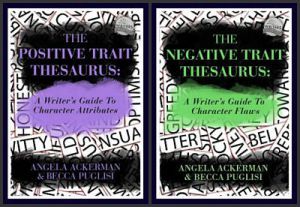 Also, we’ve currently got a giveaway going at Amazon. If you’d like to score one of 3 kindles copy of The Negative Trait Thesaurus or The Positive Trait Thesaurus, just click the links to throw your hat in the ring!
Also, we’ve currently got a giveaway going at Amazon. If you’d like to score one of 3 kindles copy of The Negative Trait Thesaurus or The Positive Trait Thesaurus, just click the links to throw your hat in the ring!The post Emotional Wound Thesaurus Entry: Failing at School appeared first on WRITERS HELPING WRITERS™.
May 18, 2016
How To Turn Your Setting Into An Obstacle Course
As you can imagine, with only a month between us and release day for the Setting Thesaurus books, Becca and I are practically twitching with excitement. More than anything, we can’t wait to show how this versatile element of storytelling is no mere wallflower. No, the setting is a powerful tool, one with the ability to deepen characters, make a story more meaningful and compelling, and of course, juice every scene with emotion and conflict.
(And that’s just to start!)
 Becca and I are big believers in making the setting work hard in EVERY scene. A terrific way to do this is to turn a setting into a magnet for conflict. After all, the hero or heroine’s path to their goal should never be a leisurely stroll. Instead, we want bumps and upsets, a route paved with inconvenience and obstacles. A sunny walk through the park should have the storytelling equivalent of hot lava to navigate, a swath of man-eating grass, and heck, maybe even a zombie toddler or two stumbling around looking for their next man-sized happy meal.
Becca and I are big believers in making the setting work hard in EVERY scene. A terrific way to do this is to turn a setting into a magnet for conflict. After all, the hero or heroine’s path to their goal should never be a leisurely stroll. Instead, we want bumps and upsets, a route paved with inconvenience and obstacles. A sunny walk through the park should have the storytelling equivalent of hot lava to navigate, a swath of man-eating grass, and heck, maybe even a zombie toddler or two stumbling around looking for their next man-sized happy meal.
Conflict keeps readers reading. It transforms lumpy gobs of description into a vivid landscape of activity. It creates tension–that tingly, uncomfortable pressure that builds in a reader’s chest as they worry about the outcome. (And as writers, we LOVE making them feel that!)
Not only do obstacles create tension and conflict, they also force our protagonist into a corner, providing the perfect opportunity for us to test their mettle.
CREATE A GAUNTLET OF CHALLENGES
There are many different ways to use the setting to stress the hero or heroine, triggering a response that shows, not tells, who they really are. Here are a few to sink your teeth into.
Inherent Dangers
 Any setting has the potential to cause trouble for the protagonist. Whether it is Lego strewn across the family room carpet as your character breaks into a house to steal important documents, a river that runs deeper than it appears, or a driver texting rather than watching the crosswalk your heroine is on, danger is everywhere. Look to the natural environment your character is in and ask yourself, what could go wrong here? Then, if it makes sense for the story, set your character on a crash course with danger. Not only will this cause the reader’s pulse to race, how your character responds will show readers what they are made of.
Any setting has the potential to cause trouble for the protagonist. Whether it is Lego strewn across the family room carpet as your character breaks into a house to steal important documents, a river that runs deeper than it appears, or a driver texting rather than watching the crosswalk your heroine is on, danger is everywhere. Look to the natural environment your character is in and ask yourself, what could go wrong here? Then, if it makes sense for the story, set your character on a crash course with danger. Not only will this cause the reader’s pulse to race, how your character responds will show readers what they are made of.
Misfortune
 On the other side of the danger coin is plain old bad luck. Sometimes unforeseen events land in our character’s lap at the worst time, and guess what makes that happen? That’s right, the setting. From bad weather that makes travel difficult, to a car breakdown, to being in the wrong place at the wrong time and witnessing a murder, misfortune creates mayhem. How does your character react–fight, or flight? Do they wallow, retreat, throw in the towel? Or do they shake off disappointment and regroup with a new plan?
On the other side of the danger coin is plain old bad luck. Sometimes unforeseen events land in our character’s lap at the worst time, and guess what makes that happen? That’s right, the setting. From bad weather that makes travel difficult, to a car breakdown, to being in the wrong place at the wrong time and witnessing a murder, misfortune creates mayhem. How does your character react–fight, or flight? Do they wallow, retreat, throw in the towel? Or do they shake off disappointment and regroup with a new plan?
Remember with misfortune, a little goes a long way. If you use it, ensure your event is logical for the setting and the circumstances so it never comes off as a plot device.
Physical Roadblocks
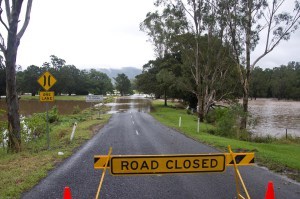 In every scene, your character has a goal. Physical obstacles can be a great way to derail the protagonist’s progress or cause painful delays.
In every scene, your character has a goal. Physical obstacles can be a great way to derail the protagonist’s progress or cause painful delays.
Whether the hero or heroine is stopped short by a locked door, missing car keys, a washed out bridge, or a forest fire caused by a lightning strike, roadblocks force detours. This challenge can showcase their creative problem solving and adaptability, as well as test their resolve.
People and Obligations
 Ah, people. There they are, all around your character–family, friends, strangers, enemies. Running into one at a bad time is no fun in real life, and can cause big problems in the fictional world. Did that nosy neighbor see something she shouldn’t have? Do the parents of your hero show up for a surprise visit just as his swingers’ party is getting underway? Does your heroine stumble upon a backwoods meth camp while out looking for her lost horse? People can be natural disruptors, messing up plans and creating complications.
Ah, people. There they are, all around your character–family, friends, strangers, enemies. Running into one at a bad time is no fun in real life, and can cause big problems in the fictional world. Did that nosy neighbor see something she shouldn’t have? Do the parents of your hero show up for a surprise visit just as his swingers’ party is getting underway? Does your heroine stumble upon a backwoods meth camp while out looking for her lost horse? People can be natural disruptors, messing up plans and creating complications.
This goes double for the people your character is obligated to. Real world problems stemming from relationships add realism while creating a quagmire of problems to navigate. Take the hero’s sister dumping her kids at his apartment because she needs to check herself into rehab. Caring for children when he wasn’t expecting to will create some stress, sure…but if he also happens to have his own demons to contend with, the situation can become dangerous. Imagine becoming suddenly responsible for two young children while he’s actively trying to dodge loan shark tough guys looking to collect an overdue payment. Now, the repercussions of his obligation is no longer a mere inconvenience. It could lead to a child being hurt.
The Little Things
 If every challenge and obstacle was some catastrophic event, we’d be tangoing with melodrama in no time. Luckily, little obstacles can be just as effective and remind readers of the real world. After all, who hasn’t spilled coffee on their slacks right before an interview, taken the wrong bus on route to an important doctor’s appointment, or discovered a broken tent pole only after completing a four hour hike into the mountains? The little things are like midges biting at the skin, and how gracefully (or not) your protagonist bears the pain as things pile up will humanize him to readers and teach him resilience, something he’ll need if he’s in it for the long haul.
If every challenge and obstacle was some catastrophic event, we’d be tangoing with melodrama in no time. Luckily, little obstacles can be just as effective and remind readers of the real world. After all, who hasn’t spilled coffee on their slacks right before an interview, taken the wrong bus on route to an important doctor’s appointment, or discovered a broken tent pole only after completing a four hour hike into the mountains? The little things are like midges biting at the skin, and how gracefully (or not) your protagonist bears the pain as things pile up will humanize him to readers and teach him resilience, something he’ll need if he’s in it for the long haul.
If you find your scene is flagging, try planting an obstacle or two in your character’s path. Besides, whatever it is your protagonist wants most is something they need to fight for. Winning becomes so much more of a rush for readers when the protagonist has really worked for it.
How do you challenge your characters? What are some of the obstacles you’ve thrown in their path? Let us know in the comments!
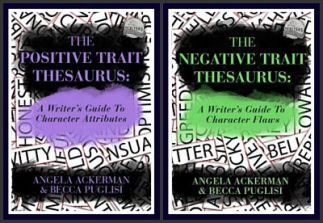 Oh and before I forget, Becca and I have 2 week-long giveaways going on at Amazon to get us all revved up for release day. If you’d like to snag a copy of The Positive Trait Thesaurus or The Negative Trait Thesaurus (or both!), just follow the links to enter. Good luck!
Oh and before I forget, Becca and I have 2 week-long giveaways going on at Amazon to get us all revved up for release day. If you’d like to snag a copy of The Positive Trait Thesaurus or The Negative Trait Thesaurus (or both!), just follow the links to enter. Good luck!
And if you might be willing to help out with our launch week festivities, let us know. We’d love your help. 
Image #2: heysalzmanngmailcom
Image #3: Stux @ Pixabay
Image #4: Sandid @ Pixabay
Image #5: Founry @Pixabay
Image #6: StevePB @ Pixabay
The post How To Turn Your Setting Into An Obstacle Course appeared first on WRITERS HELPING WRITERS™.
May 17, 2016
Critiques 4 U
Check us out on Goodreads!
![Pageflex Persona [document: PRS0000046_00067]](https://i.gr-assets.com/images/S/compressed.photo.goodreads.com/hostedimages/1463571637i/19132852.jpg)
No, seriously. Check us out.
PEOPLE! Both volumes of The Setting Thesaurus are being uploaded for proofing AS WE SPEAK! These books have been in the works for almost two years and we’re so excited to be able to offer them to you this June. If you want to stay up-to-date on these publications and the ensuing launch awesomeness, feel free to sign up here.
In the meantime, now’s a good time to do some critiques, before the final weeks of craziness kick in. If you’re working on a first page and would like some objective feedback, please leave a comment that includes:
1) your email address. Some of you have expressed concern about making your email address public; if you’re sure that the email address associated with your WordPress account is correct, you don’t have to include it here. But if you do win and I’m unable to contact you through that email address, I’ll have to choose an alternate winner.
2) your story’s genre (no erotica, please)
ONLY ENTRIES THAT FOLLOW THESE INSTRUCTIONS WILL BE CONSIDERED
Three commenters’ names will be randomly drawn and posted tomorrow. If you win, you can email me your first page and I’ll offer my feedback. Best of luck!
The post Critiques 4 U appeared first on WRITERS HELPING WRITERS™.
May 14, 2016
Emotional Wounds: Losing a Loved One To A Random Act of Violence
When you’re writing a character, it’s important to know why she is the way she is. Knowing her backstory is important to achieving this end, and one of the most impactful pieces of a character’s backstory is her emotional wound. This negative experience from the past is so intense that a character will go to great lengths to avoid experiencing that kind of pain and negative emotion again. As a result, certain behaviors, beliefs, and character traits will emerge.
 Characters, like real people, are unique, and will respond to wounding events differently. The vast array of possible emotional wounds combined with each character’s personality gives you many options in terms of how your character will turn out. With the right amount of exploration, you should be able to come up with a character whose past appropriately affects her present, resulting in a realistic character that will ring true with readers. Understanding what wounds a protagonist bears will also help you plot out her arc, creating a compelling journey of change that will satisfy readers.
Characters, like real people, are unique, and will respond to wounding events differently. The vast array of possible emotional wounds combined with each character’s personality gives you many options in terms of how your character will turn out. With the right amount of exploration, you should be able to come up with a character whose past appropriately affects her present, resulting in a realistic character that will ring true with readers. Understanding what wounds a protagonist bears will also help you plot out her arc, creating a compelling journey of change that will satisfy readers.
NOTE: We realize that sometimes a wound we profile may have personal meaning, stirring up the past for some of our readers. It is not our intent to create emotional turmoil. Please know that we research each wounding topic carefully to treat it with the utmost respect.
Losing a Loved One To A Random Act of Violence
Examples:
killed by errant bullets in a drive by shooting
a bystander gunned down during a gang dispute (in a restaurant, on the street, etc.)
a robbery where the criminals leave no witnesses
dying in a fire that was deliberately set
a child or spouse who is killed in a school shooting
a loved one who is jumped by addicts who are delusional or hallucinating
being killed in a terrorist attack (a bombing, bio-terrorism, etc.)
a love one who steps in to break up a fight and is stabbed or shot
being fatally wounded after a mugging
becoming a target because of mistaken identity
being run over as criminals flee a scene or during a police chase
dying in the line of duty (police officers, swat, bomb squad, etc.)
being grabbed and used as a human shield
being killed as a message to others (hostages, etc.)
Basic Needs Often Compromised By This Wound: safety and security, love and belonging
False Beliefs That May Be Embraced As a Result of This Wound:
evil always wins
happiness is temporary; it is only a matter of time before what you love is taken from you
I should have been able to prevent it–I am weak
I am a terrible (spouse, parent, etc.) for not protecting (the victim) when it was my duty to
it is better to not love anything than love and have it stolen from you
the system is broken, there is no protection or justice for people like (the victim)
Positive Attributes That May Result: appreciative, decisive, empathetic, generous, hospitable, introverted, just, kind, loyal, merciful, nurturing, observant, passionate, pensive, perceptive, persistent, private, protective, responsible, sensible, socially aware, spiritual, supportive, wise
Negative Traits That May Result: addictive, antisocial, confrontational, cynical, hostile, humorless, impulsive, indecisive, inflexible, insecure, irrational, needy, nervous, obsessive, paranoid, pessimistic, prejudiced, rebellious, reckless, resentful, self-destructive, stubborn, superstitious, suspicious, timid, vindictive, violent, volatile, withdrawn, worrywart
Resulting Fears:
fear of being alone
fear of darkness
fear of letting a loved one out of one’s sight
fear of not being in control
fear of specific situations (that tie into the circumstances of the loved one’s end, e. g.: being afraid to drive if one’s loved one was carjacked)
fear of a specific race, gender, or person type/features (people with facial scars, people with a similar weight and build, etc.) as the attacker
fear of trusting people
fear of certain areas that remind one of the location one’s loved one died
fear of strangers and crowded areas
Possible Habits That May Emerge:
obsessively locking and checking one’s door and window locks
repeatedly checking in with loved ones when out of sight (texts, phone calls, checking on children throughout the night, etc.)
carrying a weapon
having a cell phone always fully charged and handy
refusing to go out, making excuses to avoid crowded areas or strange people
adhering to a specific routine that one deems as “safe”
forcing one’s remaining family to adhere to safety protocols (calling for a ride not walking, calling if one is going to be late, coming home at a specific curfew, etc.)
difficulty trusting new people, remaining aloof
visiting the grave site or area where one’s loved one died often (and possibly becoming obsessive about creating and maintaining a memorial)
drinking or self-medicating more (or developing a habit)
TIP: If you need help understanding the impact of these factors, please read our introductory post on the Emotional Wound Thesaurus. For our current list of Emotional Wound Entries, go here.
For other Descriptive Thesaurus Collections, go here.
Image: Aitoff @ Pixabay
The post Emotional Wounds: Losing a Loved One To A Random Act of Violence appeared first on WRITERS HELPING WRITERS™.
Writers Helping Writers
- Angela Ackerman's profile
- 1014 followers






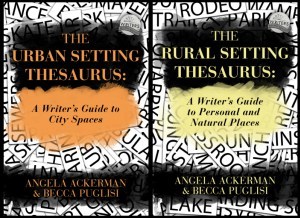

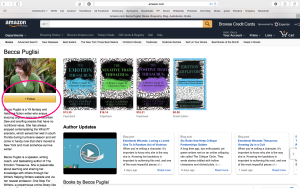
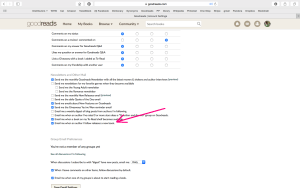
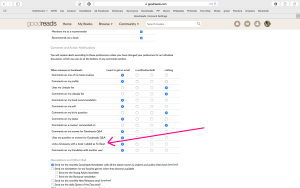
![Pageflex Persona [document: PRS0000046_00072]](https://i.gr-assets.com/images/S/compressed.photo.goodreads.com/hostedimages/1463571637i/19132851.jpg)

